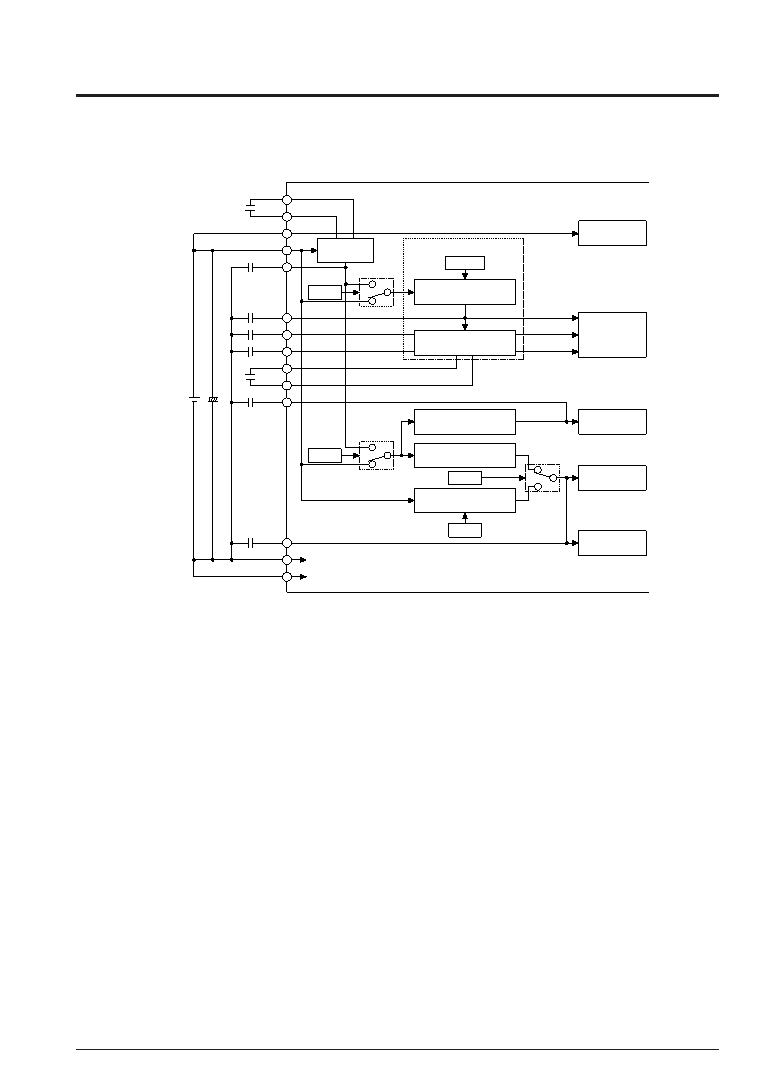- 您現(xiàn)在的位置:買賣IC網(wǎng) > PDF目錄98068 > S1C63653F 4-BIT, FLASH, 4 MHz, MICROCONTROLLER, CQFP100 PDF資料下載
參數(shù)資料
| 型號(hào): | S1C63653F |
| 元件分類: | 微控制器/微處理器 |
| 英文描述: | 4-BIT, FLASH, 4 MHz, MICROCONTROLLER, CQFP100 |
| 封裝: | CERAMIC, QFP15-100 |
| 文件頁數(shù): | 47/121頁 |
| 文件大小: | 1127K |
| 代理商: | S1C63653F |
第1頁第2頁第3頁第4頁第5頁第6頁第7頁第8頁第9頁第10頁第11頁第12頁第13頁第14頁第15頁第16頁第17頁第18頁第19頁第20頁第21頁第22頁第23頁第24頁第25頁第26頁第27頁第28頁第29頁第30頁第31頁第32頁第33頁第34頁第35頁第36頁第37頁第38頁第39頁第40頁第41頁第42頁第43頁第44頁第45頁第46頁當(dāng)前第47頁第48頁第49頁第50頁第51頁第52頁第53頁第54頁第55頁第56頁第57頁第58頁第59頁第60頁第61頁第62頁第63頁第64頁第65頁第66頁第67頁第68頁第69頁第70頁第71頁第72頁第73頁第74頁第75頁第76頁第77頁第78頁第79頁第80頁第81頁第82頁第83頁第84頁第85頁第86頁第87頁第88頁第89頁第90頁第91頁第92頁第93頁第94頁第95頁第96頁第97頁第98頁第99頁第100頁第101頁第102頁第103頁第104頁第105頁第106頁第107頁第108頁第109頁第110頁第111頁第112頁第113頁第114頁第115頁第116頁第117頁第118頁第119頁第120頁第121頁

S1C63653 TECHNICAL MANUAL
EPSON
23
CHAPTER 4: PERIPHERAL CIRCUITS AND OPERATION (Power Control)
4.2 Power Control
4.2.1 Configuration of power supply circuit
The S1C63653 has built-in power supply circuits shown in Figure 4.2.1.1 so the voltages to drive the CPU,
internal logic circuits, oscillation circuits and LCD driver can be generated on the chip.
External
power
supply
LCD system
voltage regulator
LCD driver
CC
CD
VDDA
VDD
VD2
VC1
VC2
VC3
CA
CB
VOSC
VD1
VSS
VSSA
VC1
VC2
VC3
VD1L
VOSC
VD3
VD2=1/2 VDD
VD1
Voltage
halver
Voltage booster
LCD system voltage circuit
LPWR
VDC3
VDC2
VDC0
VDC1
Low-speed operation
voltage regulator
Voltage regulator for
OSC1 oscillation circuit
OSC1
oscillation circuit
CPU,
internal circuits
R/f
converter
High-speed operation
voltage regulator
OSC3
oscillation circuit
+
Fig. 4.2.1.1 Built-in power supply circuit
Voltage regulator for OSC1 oscillation circuit
This voltage regulator always operates to generate the VOSC voltage (0.98 V Typ.) for driving the
OSC1 oscillation circuit.
Low-speed operation voltage regulator
The low-speed operation voltage regulator always operates to generate the VD1L voltage (1.25 V Typ.)
for driving the internal logic circuits. The VD1L voltage is used as the VD1 operating voltage of the
CPU and internal logic circuits when they are driven with the OSC1 clock (32 kHz). VD1 should be
switched using software according to the operating clock.
High-speed operation voltage regulator
The high-speed operation voltage regulator generates the VD3 voltage (2.0 V Typ.) for driving the
OSC3 oscillation circuit and the internal logic circuits in high-speed mode. Since this regulator stops
normally, turn it on using the VDC1 register (VDC1 = "1") and switch the internal logic operating
voltage to VD3 using the VDC0 register before starting the OSC3 oscillation.
LCD system voltage circuit
The LCD system voltage circuit generates the LCD drive voltage. This circuit can be turned on and off
using the LPWR register. Turn this circuit on (LPWR = "1") before starting display on the LCD.
The LCD system voltage circuit generates VC1 with the built-in voltage regulator, and generates two
other voltages (VC2 = 2VC1, VC3 = 3VC1) by boosting VC1. The VC1 voltage value can be adjusted using
software in 16 steps (0.95 to 1.40 V). Refer to Section 4.8, "LCD Driver", for control of the VC1 voltage
(contrast). This circuit does not operate when an external power supply is selected by mask option for
driving the LCD.
相關(guān)PDF資料 |
PDF描述 |
|---|---|
| S1C6F567D0A0100 | MICROCONTROLLER, UUC141 |
| S1C6N3B0D0A0100 | MICROCONTROLLER, UUC54 |
| S1C6P366D0A0100 | 4-BIT, FLASH, 4.1 MHz, MICROCONTROLLER, UUC102 |
| S1C6P466D0A0A00 | MICROCONTROLLER, UUC140 |
| S1C6S2L7D | 4-BIT, MROM, 0.032 MHz, MICROCONTROLLER, UUC58 |
相關(guān)代理商/技術(shù)參數(shù) |
參數(shù)描述 |
|---|---|
| S1C63656 | 制造商:EPSON 制造商全稱:EPSON 功能描述:4-bit Single Chip Microcomputer |
| S1C63657 | 制造商:EPSON 制造商全稱:EPSON 功能描述:CMOS 4-bit Single Chip Microcontroller |
| S1C63658 | 制造商:EPSON 制造商全稱:EPSON 功能描述:4-bit Single Chip Microcomputer |
| S1C63666 | 制造商:EPSON 制造商全稱:EPSON 功能描述:4-bit Single Chip Microcomputer |
| S1C63709 | 制造商:EPSON 制造商全稱:EPSON 功能描述:4-bit Single Chip Microcomputer |
發(fā)布緊急采購,3分鐘左右您將得到回復(fù)。